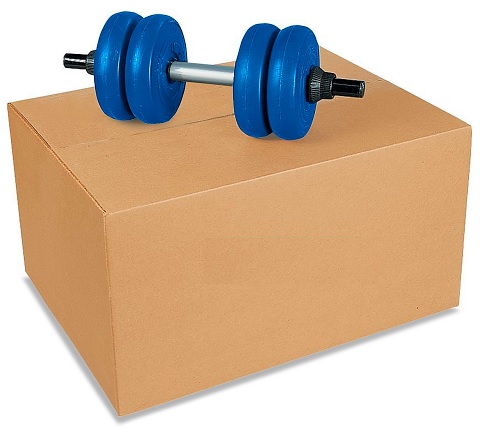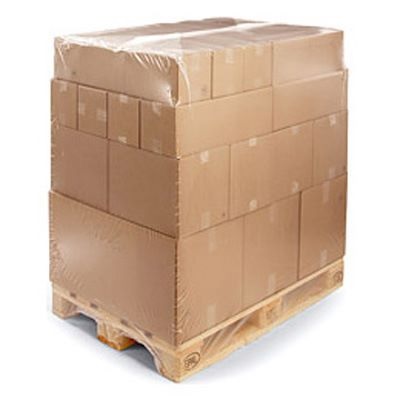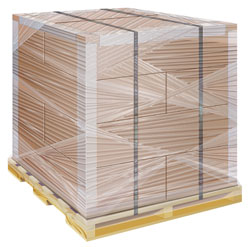|
|
Select your destination country above to calculate international shipping costs from the U.S.
Palletizing and crating in shipping goods from the USA internationally
In most cases, ocean-bound exports originating from the USA must be properly unitized.
Most of the time, ocean-bound exports from the USA require proper unitization. During transoceanic transit, unitized and shrink-wrapped loads are moved by forklifts to ensure secure handling. While you can ship 3 to 5 loose items overseas, heavy or oversized freight must be secured on a shipping skid for maritime transport.
Click the image to watch a video on preparing cargo skids for international shipping from the U.S.
Keeping freight on skids offers clear advantages but also has drawbacks.
Here are the advantages of consolidated cargo:
-
A forklift can handle skidded loads, increasing the chances of reaching the destination without physical damage or loss.
-
All items on shipping platforms are kept together, ensuring no missing pieces for unitized shipments.
-
Export loads are protected against unauthorized access, theft, and other risks through industrial shrink wrapping.
However, additional ocean freight costs may be incurred due to "dead volume" in pallet-based transportation.

Load unitization incurs additional volume-based charges, but it's often worth it for enhanced cargo safety and economical global logistics. Letting an experienced freight forwarder handle skid preparation helps avoid errors and ensures regulatory compliance for exports. Sea freight carriers typically do not ship un-unitized inventory internationally from the USA.
Shipping loose boxes
Typically, you can ship a few individual cartons loose. You can ship standard cardboard moving boxes in various sizes. However, if you send parcels loose, we recommend using heavy-duty, export-grade containers for added protection. Order online in advance. We may recommend Uline.com.

Ship boxes from the USA overseas
Shipping goods in unbound cartons overseas has both pros and cons.
Advantages: A key benefit is avoiding extra costs for “dead volume.” LCL rates are based on the total volume of individual packages.
Disadvantages: Transporting many small loose boxes using Less Than Container Load (LCL) isn't safe. Each carton is handled manually, increasing the risk of damage, loss, or theft during ocean transit.
If you ship three to five units, you can request that they be shipped loose. However, for larger export shipments or items over 100 lbs, the ocean freight terminal may require skidding, even without a request.
Shipping overseas palletized cargo.
A standard U.S. shipping platform measures 48 inches (1.2 m) by 40 inches (1.0 m) by 6 inches (0.15 m). When freight bases are loaded with goods, they are often referred to as "skids."
Loose cargo must be unitized into skids at an ocean carrier's terminal (Container Freight Station or CFS). Each skidded load should hold as many boxes as possible, but the height should not exceed 60 inches (1.52 m). The height depends on the packaging strength, weight, and size. After packing, freight units should be shrink-wrapped with plastic film.
Many shipping base sizes and types are used for U.S. exports. Loads must be easy to handle with forklifts. The bottom of the skids should have at least 3.5 inches of clearance for pallet jacks to operate smoothly. Assembled units should also fit into a 40-foot ocean container.
If you palletize your freight for global shipment, follow the heat-treated wood standards (ISPM 15) that apply to all ocean cargo leaving the United States.

Ship pallets from the USA
Shipping goods internationally using industrial skids offers numerous benefits but also has some disadvantages.
BENEFITS:
- Unitized cargo is less likely to be damaged or lost during ocean transit. When handled correctly, forklifts can easily move skidded freight. The items on the shipping base are securely fastened, significantly reducing the risk of parts of the consignment being lost. Consolidated loads are also better protected from unauthorized access and theft throughout the logistics cycle.
- If you deliver loose items to a Container Freight Station (CFS), they will prepare the skids and shrink-wrap them. Palletizing services typically range from $35 to $50 per unit, including the CFS-certified heat-treated base fee. It is better to let CFS professionals handle load consolidation than to do it yourself. Delivering loose shipping cartons is simpler to handle.
- By letting the CFS unitize your cargo, you also transfer the responsibility for ISPM 15 compliance to them. This means you shouldn't encounter any issues with wood-packing regulations when exporting freight from the USA.
DISADVANTAGES: You may incur additional transportation charges for skidding. This includes:
-
A fee for the cost of the materials and the labor involved
-
Additional chargeable volume, known as "dead volume."
If your freight requires unitization and the CFS cargo recipient is not aware of it when you deliver, don't worry. This usually happens because the employee hasn't yet received the loading instructions.
Submit your items and ensure that the terminal staff records the number of boxes you submitted on a copy of your dock receipt. They should date and sign it. Keep this copy as proof of delivery.
We will confirm the preparation once you receive the warehouse receipt from the CFS. Your freight will be palletized correctly, and we will notify you accordingly.
Chargeable cargo volume estimation
The ocean carrier will increase the billable volume when smaller items are consolidated on skids.
The ocean freight provider will charge a fee for unitizing and wrapping. This fee typically ranges from $35 to $50 per unit and includes the cost of the shipping platform itself. The carrier may also apply an hourly labor fee if you deliver many parcels. Please note that skidding costs are not included in the freight quotes generated by our online calculator. These charges will be calculated after load preparation is completed and added to our final invoice. We do not markup these charges. You will see a breakdown of the charges in the rated bill of lading.
The total chargeable (gross) volume is always based on the longest, widest, and highest dimensions of your completed skid, regardless of the sizes and shapes of the items it contains. Please check the accompanying images for a clear example of this volumetric measurement.
 For example, a skidded load with the largest size of 40 x 50 x 50 inches equals 1.65 gross cubic meters, or 58 gross cubic feet, regardless of the size of the boxes.
For example, a skidded load with the largest size of 40 x 50 x 50 inches equals 1.65 gross cubic meters, or 58 gross cubic feet, regardless of the size of the boxes.GUIDELINES FOR PALLETIZING
Wood Packing Rules (ISPM 15): When packing your export cargo for overseas shipping from the USA using wooden bases, be aware of the international heat-treatment restrictions.
Labeling Your Shipment: Always label your items before stacking them. Remove any old labels to avoid confusion. This will help identify your packages if the skid wrap gets damaged during international transit.
DO NOT WRITE ANYTHING ON YOUR BOXES about the commodity inside the boxes. You will provide cargo descriptions in your commercial invoices or valued packing lists. It will then be submitted electronically to your shipment file.
SIZE AND WEIGHT: If shipping LCL cargo from the U.S., all units should not exceed 2,200 lbs by weight, 70" in height, 119" in length, and 80" in width. Otherwise, such oversized freight requires approval from the ocean carrier before it can be accepted for maritime transport.
SAFETY ON LOADING AND STACKING BOXES INTO SKIDS: At the time of unitizing loose items for overseas transport from the USA, it is recommended to:
-
Distribute weight evenly. Stack boxes squarely, corner-to-corner, against the skid edge to maximize compression strength, but do not allow boxes to overhang the base.
-
Keep the top of the load flat to minimize loss or damage to cartons; do not pyramid-stack.
-
Place angled fiberboard (also known as angle board) between boxes to prevent crushing.
-
Cover the top of the skidded units with plastic film to protect your boxes from weather damage during transit from the USA to overseas destinations.
SECURING OF SKIDS: Wrap the units in 70-gauge stretch wrap. Use at least two tightly secured bands to go through the skid voids and around all the cartons. If you can, use steel, rayon, polypropylene, nylon, or polyester strapping to secure the load. When bolting, use shock-absorber connections or cushioned skids, if applicable.
Shipping goods from the USA in crates
Crating freight for international ocean transit can be quite costly. However, in certain situations, custom crating is necessary.

International transportation of valuable or fragile items often requires protective crates. You can buy solid export crates from packing companies or order them online.
It may be a good idea to hire a local packing company to crate your goods for shipping from the U.S. Be sure to ask whether they are familiar with global logistics regulations, particularly ISPM 15 wood regulations.
When shipping from the U.S. using LCL (Less than Container Load), wooden crates must be liftable by a forklift and should fit easily into a 40-foot sea container.

Mixing shipping units in transportation from the USA
When exporting goods overseas, consider using various types of packaging units. Utilizing the right combination of crates, skids, and parcels can significantly reduce your international shipping costs. Use unitized skids for smaller items, crates for valuable or fragile items, and leave oversized items loose. This method helps keep your valuables safe and can lower LCL freight costs when using sea freight services from the United States.


.png)



